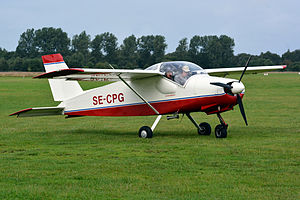Malmö MFI-9
| MFI-9 Junior | |
|---|---|
 |
|
| A Malmö MFI-9, (SE-CPG), at Uetersen Airport, Germany | |
| Role | Primary trainer |
| Designer | Björn Andreasson |
| First flight | 10 October 1958 |
| Introduction | 9 August 1962 |
| Variants | Saab Safari |
The Malmö Flygindustri MFI-9 Junior was a light aircraft produced in Sweden in the 1960s. The aircraft was also produced under license as the Bölkow Bo 208.
The BA-7 was designed by Björn Andreasson and flown by him in prototype form on 10 October 1958. He built this first plane in his spare time while working for Convair in the United States. It was powered by an air-cooled Continental A-75 engine giving 56 kW (75 hp) driving a two-bladed variable-pitch propeller. The shoulder wings were forward swept to place occupants ahead of the spar for visibility.
In 1960 Andreasson returned to Sweden and started working at Malmö Flygindustri where he designed an improved version of the BA-7 that went into production as the MFI-9 Junior. Changes included a larger cockpit and the powerplant was now a Continental O-200-A flat-four-cylinder air-cooled piston engine giving 75 kW (100 HP). In 1963 it was followed by the MFI-9B Trainer and then the MFI-9B Mili-Trainer.
The MFI-9 uses a tricycle undercarriage.
Between 1963 and 1971, 210 Bölkow Bo 208s were built under licence by Bölkow Apparatebau GmbH in Laupheim, Germany. Many examples survive in private hands and are most commonly found in Germany, the United Kingdom and Scandinavia. A limited number of airworthy examples can be found in both the United States and New Zealand.
The most widely produced variant of the Bo 208 is the Bo 208C, which used a Continental O-200-A flat-four-cylinder air-cooled piston engine giving 75 kW (100 HP). A number of O-200 engines installed on Juniors were licence-built by Rolls-Royce in England.
One variant of the MFI-9 which gained widespread fame was the MiniCOIN (an acronym for "Miniature Counter-Insurgency"), a modification of the MFI-9B military trainer variant of the MFI-9, adapted to carry weapons.
...
Wikipedia
